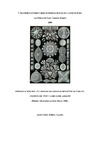Identificador persistente para citar o vincular este elemento:
https://accedacris.ulpgc.es/jspui/handle/10553/8707
| Campo DC | Valor | idioma |
|---|---|---|
| dc.contributor.advisor | Courtois de Viçose, G. | - |
| dc.contributor.author | Porta-Vales, Anastasia | - |
| dc.date.accessioned | 2012-10-31T14:08:48Z | - |
| dc.date.accessioned | 2018-05-15T10:56:48Z | - |
| dc.date.available | 2012-10-31T14:08:48Z | - |
| dc.date.available | 2018-05-15T10:56:48Z | - |
| dc.date.issued | 2009 | en_US |
| dc.identifier.uri | https://accedacris.ulpgc.es/handle/10553/8707 | - |
| dc.description | V Máster Universitario Internacional en Acuicultura | en_US |
| dc.description.abstract | Diatom cell quantity and their biochemical composition vary among species and are greatly affected by harvest stage or culture conditions. Biometric parameters, growth, attachment capacity and variations in biochemical composition of four species of benthic diatoms (Amphora sp., Navicula incerta, Nitzschia sp. and Proschkinia sp.) were studied. For biochemical analysis the diatoms were harvested at different stages, in log and stationary phase of growth. The culture conditions were identical for all the experiments, benthic diatoms were cultured during 7 days in F/2 medium at 28.5 ± 1.4 ºC, at different original inoculating densities (50000, 100000, and 250000 cell mL-1), under continuous light of 5403 ± 649 Lux provided by cool white fluorescent lighting. The cultures were neither aerated nor agitated. These results show that the specific density of 10000 cell mL-1 was the best for weekly production: Proschkinia sp. reached the highest cell density of 5.81 x 106 cells mL-1 and Amphora sp. had the highest cell attachment capacity with 12000 cell mm-2, in stationary phase of growth. Protein and lipid content were higher in log phase than in stationary phase for the four diatoms. Amphora sp. in log phase of growth had the highest lipid content of 9.74% dry weight (DW). Polyunsaturated fatty acid (PUFA) content ranged from 23.25% to 38.62% of the total fatty acids (TFA), and the four diatoms tested were richer in n-3 PUFA than in n-6 PUFA. All the diatoms had significant quantities of 20:5n-3 (EPA) ranging between 12.69% and 17.68% of TFA. Benthic diatoms play an important and critical role in abalone culture as they are the principal food source of abalone post-larvae. Therefore, it is necessary to improve diatom quantity and quality to optimize post-larval nutrition and the consistency of production, resulting in an increase in growth and survival of abalones. | en_US |
| dc.language | spa | en_US |
| dc.subject | 251092 Acuicultura marina | en_US |
| dc.subject | 310502 Piscicultura | en_US |
| dc.subject.other | Benthic diatom | en_US |
| dc.subject.other | Growth | en_US |
| dc.subject.other | Cell attachment | en_US |
| dc.subject.other | Biochemical composition | en_US |
| dc.subject.other | Abalone | en_US |
| dc.title | Optimización del cultivo de diatomeas bentónicas para el cultivo de post-larvas de abalón ("Haliotis tuberculata coccinea" Reeve, 1846) | en_US |
| dc.type | info:eu-repo/semantics/masterThesis | en_US |
| dc.type | MasterThesis | en_US |
| dc.compliance.driver | 1 | es |
| dc.contributor.facultad | Facultad de Ciencias del Mar | en_US |
| dc.identifier.crisid | - | - |
| dc.investigacion | Ciencias | en_US |
| dc.rights.accessrights | info:eu-repo/semantics/openAccess | es |
| dc.type2 | Trabajo final de máster | en_US |
| dc.description.notas | Máster en Acuicultura ; 2009. Trabajo realizado en el Instituto Canario de Ciencias Marinas (ICCM) de Las Palmas de Gran Canaria | en_US |
| dc.utils.revision | Sí | en_US |
| dc.identifier.ulpgc | Sí | en_US |
| item.grantfulltext | open | - |
| item.fulltext | Con texto completo | - |
| crisitem.advisor.dept | GIR Grupo de Investigación en Acuicultura | - |
| crisitem.advisor.dept | IU de Investigación en Acuicultura Sostenible y Ec | - |
| Colección: | Trabajo final de máster | |
Visitas
144
actualizado el 18-may-2024
Descargas
1.220
actualizado el 18-may-2024
Google ScholarTM
Verifica
Comparte
Exporta metadatos
Este elemento está sujeto a una licencia Licencia Creative Commons

